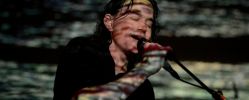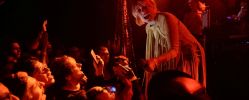
“Elvis at 21” Photo Exhibit Opens at GRAMMY Museum

ELVIS AT 21: PHOTOGRAPHS BY ALFRED WERTHEIMER
In 1956, photojournalist Alfred Wertheimer was hired by RCA Victor to shoot promotional images of a recently signed 21-year-old recording artist (Presley), and his instincts to “tag along” with the artist after the assignment resulted in 56 striking images that provide an intimate look at Elvis before he exploded onto the scene and became one of the most exciting performers of all time. The exhibit will run through March 28, 2010.
Developed collaboratively by the Smithsonian Institution Traveling Exhibition Service (SITES), the Smithsonian’s National Portrait Gallery and the Govinda Gallery, the Elvis at 21 exhibition — sponsored nationally by The History Channel — will travel to museums around the country through 2013 following its premiere at the GRAMMY Museum.
Wertheimer had unparalleled access and documented Elvis on the road, backstage, in concert, in the recording studio and at home in Memphis, Tenn. “Colonel” Tom Parker, Elvis’ manager, restricted contact just a short time later. The photographs document a remarkable time when Elvis could sit alone at a drugstore lunch counter.
“Henri Cartier-Bresson was known for photographing what he called the ’decisive moment,’ that moment when everything falls into place,” said Wertheimer. “But I was more interested in the moments before or after the decisive moment.”
Wertheimer was up close to capture a flirtatious encounter with a young woman backstage in Richmond, Va. He was in the New York City recording studio on the historic day Elvis recorded “Don’t Be Cruel” and “Hound Dog,” the b-side to that record. Both songs hit No. 1 on the charts, the first and only time a single record would achieve this distinction.
Wertheimer also joined Elvis after the recording session as he traveled home to Memphis by train. One image shows Elvis as just part of the crowd surrounding a lunch vendor on a train platform during a brief stop on the 27-hour trip. The anonymity he had during this stop was short-lived; the trip followed a busy few months when Elvis appeared on the television shows “Stage Show,” “The Milton Berle Show” and “The Steve Allen Show.” The photographs of a concert in Russwood Park on his return to Memphis show a young man who now had to have a police escort to get through the crowd of fans between his car and the stadium.
Elvis at 21 is accompanied by a richly illustrated catalog, titled “Elvis 1956,” available through Welcome Books. For more information, visit http://welcomebooks.com/elvis1956.











